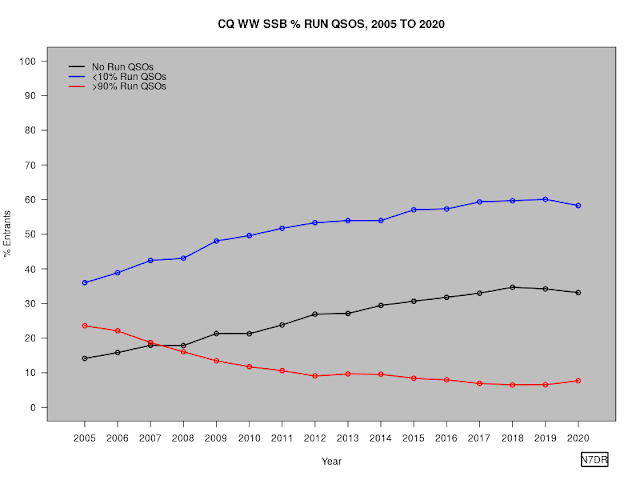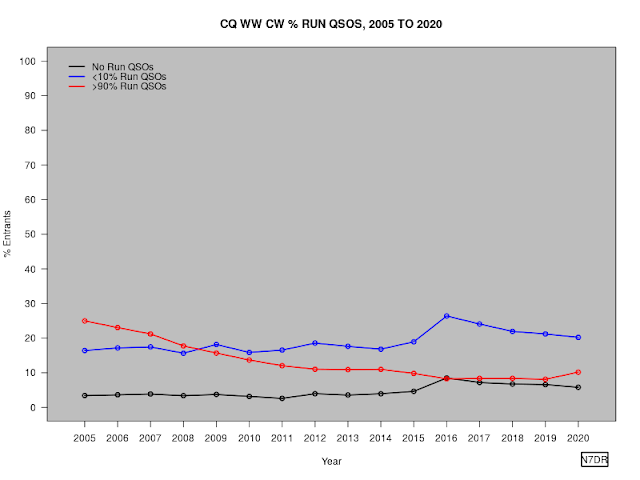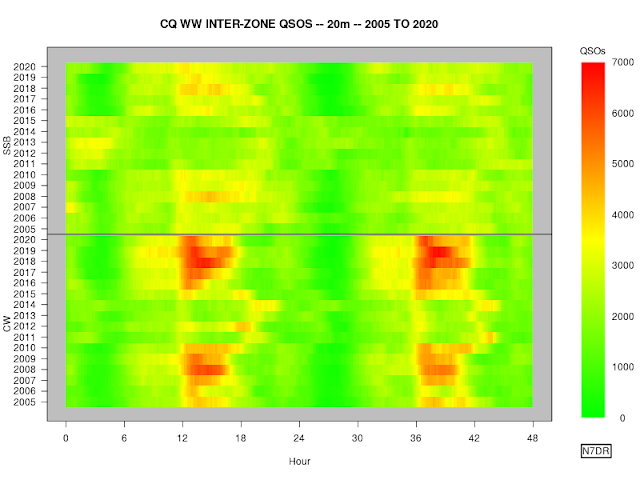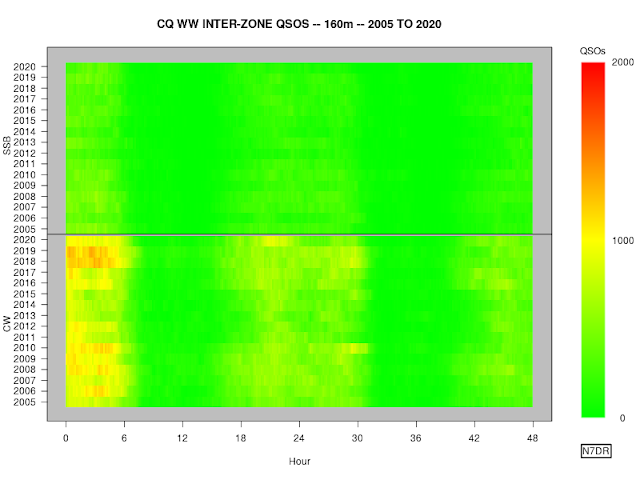As usual, there follow a few basic analyses that interest me. There is, of course, plenty of scope to use the files for further analyses, some of which are suggested by the figures below.
Below are some simple analyses of basic statistics from the logs. The 2020 versions of the contests were, of course, run under the unique circumstance of a world-wide pandemic. So we can expect the data for 2020 to be unlike those for any other year. Whether 2020 changes any long-term trends will take a year or two to become clear.
Number of Logs
Until 2020, the raw number of submitted logs for SSB had been relatively flat for
several years; the logs submitted for CW showed a fairly
steady annual increase. In 2020, unsurprisingly, the number of logs in both modes increased:
One not infrequently reads statements to the effect that the popularity of contests such as CQ WW has long been increasing. This plot suggests that this has not been true for a number of years prior to 2020 (and even when it was true, there are alternative explanations for the year-on-year increase, such as increasing ease of electronic log submission). This year, because of the unique circumstances, one would reasonably expect that there really were more people sitting at home and spending at least a portion of the weekend(s) on the air. But, as we see in the next section, that doesn't really seem to have been the case.
Popularity
By definition, popularity requires some measure of people (or, in our case, the simple proxy of callsigns) -- there is no reason to believe, a priori, that the number of received logs as shown above is related in any particular way to the popularity of a contest.
So we look at the number of calls in
the logs as a function of time, rather than positing any kind of
well-defined positively correlated relationship between log submission
and popularity (actually, the posts I have seen don't even bother to
posit such a relationship: they are silent on the matter, thereby simply
seeming to presume that the reader will assume one).
However, the situation isn't as
simple as it might be, because of the presence of busted calls in logs.
If a call appears in the logs just once (or some small number of times),
it is more likely to be a bust rather an actual participant. Where to
set a cut-off a priori in order to discriminate between busts and
actual calls is unclear; but we can plot the results of choosing
several such values.
First, for SSB:
[I note that a reasonable argument
can be made that the number of uniques will be more or less proportional
to the number of QSOs made (I have not tested that hypothesis; I leave
it as an exercise for the interested reader to determine whether it is
true), but there is no obvious reason why the same would be true for,
for example, callsigns that appear in, say, ten or more logs.]
Moving to CW:
we see a similar story to SSB, except that any decrease in participation
since the same point in the last cycle appears to be very small:
participation in the CW event in the current inter-cycle doldrums seems
to be more or less the same as at the corresponding point in the last
cycle. The uptick in 2020 was considerably higher than for the SSB weekend, which on the face of it seems rather surprising: I expected that if a substantial number of people returned to the contest because of the pandemic, they would prefer the SSB weekend; the data show, however, that that expectation was not borne out.
Geographical Participation
How has the geographical distribution of entries changed over time?
Again looking at SSB first:
Zone 28 has resumed its increase in the number of logs submitted, and the absolute number is
now considerably higher than it was five or more years ago. The number of
logs from
zones outside EU or the US (and, to a lesser extent, JA) is miniscule.
This can be seen more clearly if we plot the
percentage of logs received from each zone as a function of time:
On CW, most zones evidence a long-term increase:
But the relative increase seems to
be spread more or less evenly across all zones, with the percentages of
logs from each zone barely changing over the years 2005 to 2020 (although again what increase there is seems to be most pronounced in western Europe):
Activity
Total activity in a contest depends
both on the number of people who participate and on how many QSOs each
of those people makes. We can use the public logs to count the total
number of distinct QSOs in the logs (that is, each QSO is counted only once, even if both participants have submitted a log).
For SSB:
The
total number of distinct QSOs in the current inter-cycle doldrums is
essentially the same as at the same point in the last solar cycle.
And for CW:
On this mode there appears to be a long-lived underlying upward trend (on which the effect of the solar cycle is superimposed), perhaps augmented somewhat by the pandemic in 2020. Despite the claims I see that CW is an obsolete technology in serious decline, the actual evidence, at least from this, the largest contest of the year, is quite the opposite. (This is a good reminder that when someone makes a claim whose truth is not self-evident, one should examine the underlying data for oneself. I have found that all too often it transpires that no defensible evidence has been put forward for the conclusion being drawn.) The evidence certainly seems to indicate that CW activity is faring rather better than activity on SSB, at least insofar as CQ WW is concerned.
Running and Calling
On SSB, the ongoing gradual shift towards stations strongly favouring
either running or calling, rather than splitting their effort between
the two types of operation, finally appears to have reached some kind of
equilibrium, with essentially no change between 2018 and 2019, and even a slight reversal of the trend in 2020:
I have not investigated the cause of the decrease in the
percentage of stations strongly favouring running, although the public
logs could readily be used to distinguish possibilities that spring to
mind, such as more SO2R operation, more multi-operator stations, and/or a
reluctance of stations to forego the perceived advantages of spots from
cluster networks.
On CW, the split between callers and runners continues to be much less
bimodal than on SSB (on SSB, fully 30% of entrants have no
run QSOs; on CW, the equivalent number is below 10%). Indeed, the
difference in call/run behaviour on the two modes (and the difference in
the way that the behaviour has changed over time) is profound, and
probably worthy of further investigation. CW continues to appear to have
what would seem to be a much healthier split between the two operating
styles:
Assisted and Unassisted
We can see how the relative popularity of the assisted and unassisted categories has changed since they were introduced:
On CW, there are essentially equal numbers of assisted and unassisted
logs, while on SSB the unassisted logs handily exceeds the number of
assisted logs. My guess, for what it's worth, is that CW assistance is
more widespread partly because it (partially) absolves stations from
actually being able to copy at high speed, and partly because the RBN is
so effective that essentially all CQing stations are spotted.
I find it particularly interesting that the number of CWU logs has
remained essentially unchanged ever since the unassisted category was
created.
Looking at the number of QSOs appearing in the unassisted and assisted logs:
(The lines are for the median number of logs; the vertical bars run from
10% to 90%, 20% to 80%, 30% to 70%, 40% to 80%, with opacity increasing
in that order.)
Inter-Zone QSOs
We can show the number of inter-zone
QSOs, both band-by-band and in total. In these plots, the number of QSOs
is accumulated every ten minutes, so there are six points per hour.
In 2018, I wrote:
In 2018, activity decreased substantially on 15m as compared to 2017. We certainly seem to be very close to the bottom of the cycle. Perhaps by next year there will be a slight improvement in conditions.
That slight improvement did in fact occur in 2019 and continued into 2020, so it does seem that the new cycle is making itself felt, which bodes well for 2021. (In fact, by this metric, 15m was about as good as it ever gets in this late-November contest on CW.)
As
usual, CW dominates on 40m (and the other low bands), and the bulk
of CW DX activity was in the first few hours (unlike 2018, which was
exceptional for the activity on the last few hours of the contest).
80m was also dominated by CW, with, as usual, the bulk of DX activity in the first six hours.
The overall picture at last shows increases in the numbers of DX QSOs, especially on CW.






















No comments:
Post a Comment
Note: Only a member of this blog may post a comment.